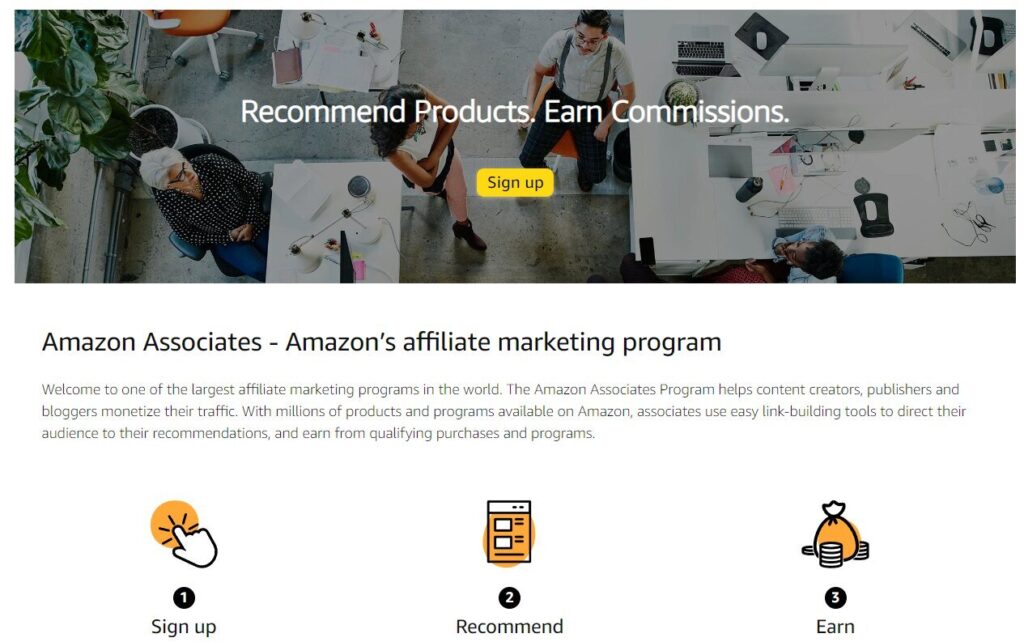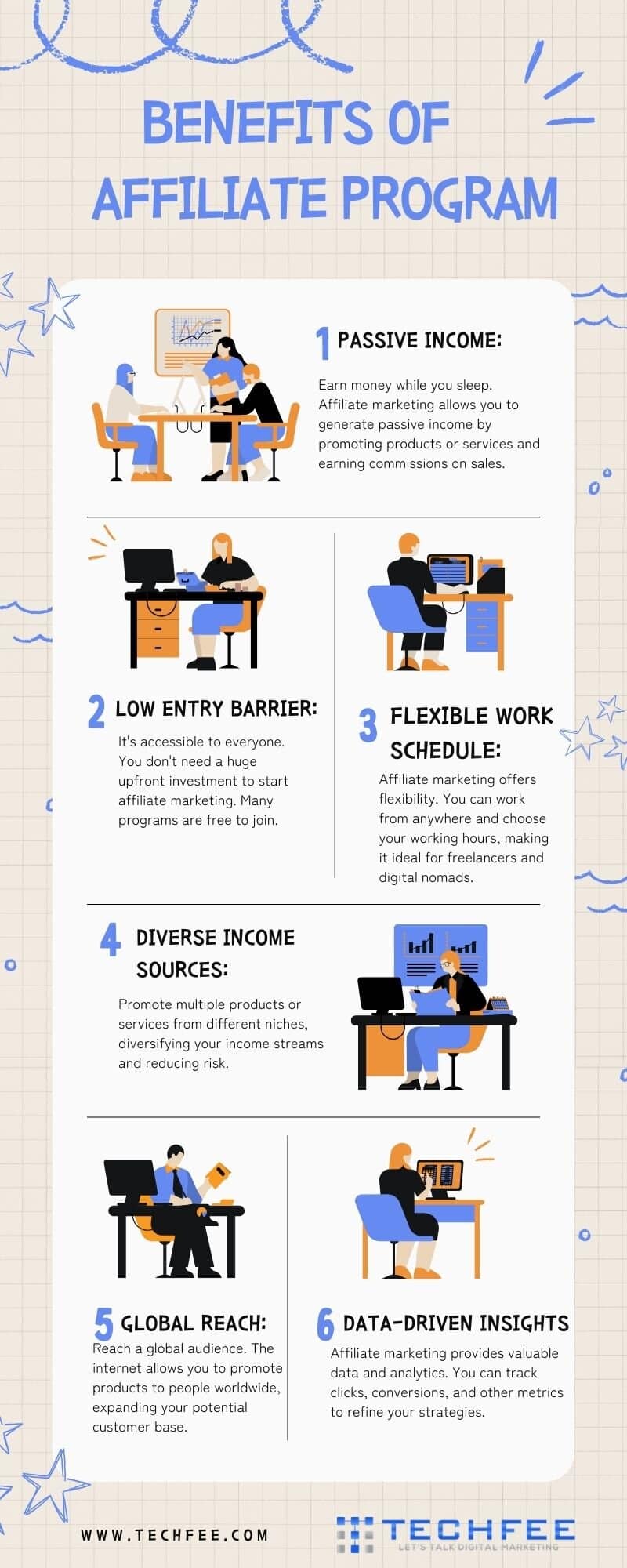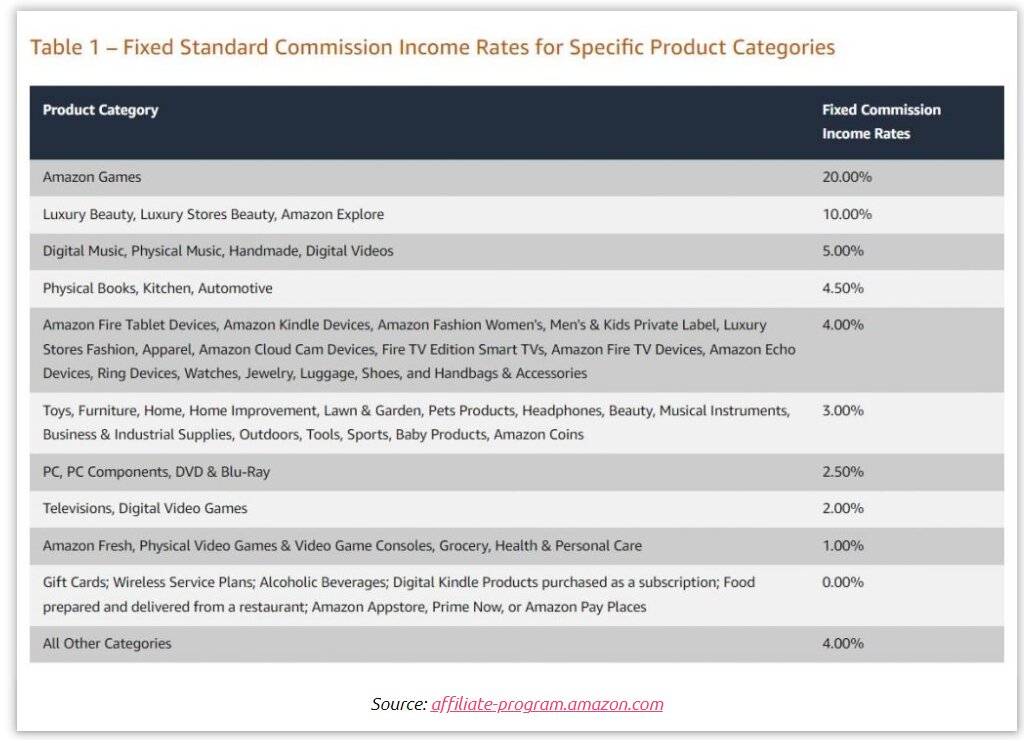Amazon Affiliate Program is key if you’ve been considering ways to turn your passion for products and content into a consistent stream of earnings.
Many of us continuously search for ways to secure a source of passive income, but the options can sometimes be overwhelming. Fortunately, the importance of passive income became crystal clear during the challenging times of the COVID-19 pandemic.
While some people were trying to save every penny to make ends meet, others who had embarked into the world of passive income found themselves much more relaxed and stress-free.
That being said, let me share a valuable tip with you: When it comes to passive income, one of the most promising avenues is affiliate marketing. And if we’re talking about affiliate marketing, there’s nothing like the Amazon Affiliate program.
Picture this: You can earn money while you sleep, on vacation, or even spend time with your loved ones. That’s the beauty of passive income. Of all the affiliate programs, Amazon stands out as a top choice. So, if you’re looking to create a steady income stream with minimal effort, consider diving into the world of the Amazon Affiliate Program – it might just be the key to unlocking a more financially secure and stress-free future for yourself.
In today’s digital age, this opportunity is just a few clicks away, offering financial rewards whether you’re a seasoned blogger, a rising influencer, or simply someone curious about online income.
In this blog post, we’ll dive into the fascinating world of the Amazon Affiliate Program, unveiling essential strategies and unique insights to set you on the path to passive income success.
Let’s open the door to a brighter financial future together!
Table of Contents
ToggleThe Basics of Amazon Affiliate Program
A. What is an Amazon Affiliate Program?

The Amazon Affiliate Program, also known as Amazon Associates, is a fantastic affiliate marketing opportunity allowing people and website owners to collaborate with Amazon, the e-commerce giant.
When you join this program, you can earn commissions by promoting Amazon’s vast range of products. It’s a mutually beneficial setup where affiliates receive a percentage of their sales through their referral links while Amazon enjoys increased sales and exposure.
This program has become a cornerstone of online income generation for countless bloggers, content creators, and website owners. It offers an easy way to turn their online presence into extra income.
Whether you’re a seasoned blogger or just dropping your toes into the online world, the Amazon Affiliate Program can be a valuable tool to monetize your online efforts.
B. How do Amazon Affiliate Programs Work?
Amazon Affiliate Programs offer an exciting opportunity for individuals and businesses to leverage their online presence for financial gain.
The process is relatively straightforward: you begin by enrolling in the program, then handpick products that resonate with your audience, and finally, you create distinct affiliate links to embed within your content.
When your visitors click on these links and make purchases on Amazon, you’ll receive a percentage of the sale as your commission.
Thanks to Amazon’s extensive range of products and its widely recognized reputation, participating in the affiliate program presents a versatile and scalable means of generating income through your website or online content.
C. Benefits of Joining Amazon's Affiliate Program
Being a part of Amazon’s Affiliate Program has many advantages, making it an appealing choice for individuals and businesses. One of the standout perks is the opportunity to generate passive income by promoting products from the world’s largest online retailer.
You can choose from various products that align with your niche or personal interests as an affiliate, making it a versatile option for bloggers, content creators, and website owners.
Furthermore, Amazon’s well-established reputation and trustworthiness can significantly enhance your credibility and boost conversion rates. Shoppers tend to have more confidence when making purchases through this reputable platform.
The program’s user-friendly sign-up process and abundant tools and resources make joining the Amazon Affiliate Program a strategic move to monetize your online presence while providing valuable recommendations to your audience.

Getting Started with the Amazon Affiliate Program
A. How to Sign up for an Amazon Affiliate Account

Step 1: Start by visiting the official Amazon Affiliate Program website. You can easily find this by searching for “Amazon Associates” in your preferred search engine.
Step 2: Once on the Amazon Associates homepage, click the “Join Now for Free” button. This will take you to the sign-up page.
Step 3: If you already have an Amazon account, log in using your existing credentials. If not, you’ll need to create one.
Step 4: You’ll be asked to provide some basic account information, including your website or app details, preferred store ID, and your preferred tracking ID. Make sure to fill out this information accurately.
Step 5: Amazon will ask you to provide details about your website or mobile app, including its niche, target audience, and how you plan to promote Amazon products.
Step 6: In this section, you’ll need to describe your methods for driving traffic to Amazon and generating sales through your affiliate links. Be honest and clear about your strategies.
Step 7: Amazon will send you a verification code to your provided phone number. Enter the code to verify your identity.
Step 8: Select your preferred payment method by check or direct deposit. Provide the necessary payment information.
Step 9: After completing all the steps, click the “Finish” button. Amazon will review your application, which may take up to several days. Once approved, you’ll receive access to your Amazon Affiliate account and can earn commissions by promoting products on your website or app.
That’s it! You’re now on your way to becoming an Amazon Affiliate and earning commissions for driving sales through your affiliate links.
B. Navigating the Affiliate Dashboard
This dashboard serves as your command center, delivering a treasure trove of data and utilities to monitor your earnings, evaluate performance, and enhance your strategies.
To kick things off, the “Overview” section is your go-to for a quick earnings snapshot.
Delve deeper into the “Reports” section, where you’ll uncover in-depth insights on clicks, conversions, and commissions, helping you discern the successes and areas needing improvement.
Under the “Links & Banners” tab, you can craft affiliate links and banners easily, while the “Product Linking” feature simplifies discovering and promoting Amazon products.
And don’t forget the “Tools” section, with valuable resources and plugins to streamline your affiliate marketing game. With some exploration and practice, you’ll become a pro at navigating the Amazon Affiliate Dashboard in no time.
C. Understanding Affiliate Links and Tracking
Affiliate links and tracking are vital in affiliate marketing, offering a crucial pathway for businesses and content creators to monetize their digital endeavors.
These affiliate links are vital for product or service providers and their affiliates, allowing them to earn commissions by directing traffic and generating sales. Yet, the true power lies in the realm of tracking.
Tracking systems provide invaluable insights into the performance of these links, delivering metrics such as clicks, conversions, and revenue generated.
This treasure trove of data is a game-changer, as it empowers affiliates to fine-tune their strategies and enables businesses to measure the effectiveness of their affiliations.
Becoming an Amazon affiliate: pros and cons
Embarking on becoming an Amazon affiliate brings advantages and disadvantages worth exploring.
On the brighter side, the Amazon Associates program presents a user-friendly gateway for individuals and businesses to monetize their websites or blogs.
Leveraging Amazon’s extensive product catalog and renowned brand reliability, affiliates gain access to a diverse customer base, all while enjoying competitive commission rates and the potential for a steady stream of passive income.
However, it’s not all sunshine and roses. Amazon’s commission structure varies across product categories, and the window of opportunity, thanks to a relatively short cookie duration, can be limited.
Moreover, affiliate earnings are subject to the ever-evolving policies of Amazon and the ever-shifting landscape of affiliate marketing. To make an informed decision, it’s essential to carefully weigh these pros and cons, ensuring they align with your specific goals for online monetization.
Building Your Affiliate Website
When you embark on the exciting journey of building your affiliate website, there are several steps to ensure your online venture ornaments.
To begin, the selection of the perfect domain name is essential. Your domain should possess a memorable, catchy quality while remaining closely aligned with your chosen niche.
Once you’ve successfully secured your domain, the next critical step is setting up reliable hosting. A trustworthy hosting provider ensures your website is accessible to visitors at all times, so selecting and finding one that matches your particular requirements is essential.
Moving forward, the choice of the right website platform is equally essential. Platforms like WordPress, renowned for their user-friendly interfaces and an array of customizable plugins, can significantly enhance your website’s functionality.
Finally, designing an affiliate-friendly website is the ultimate goal. Strive for a clean, reflexive design that caters to desktop and mobile users.
Incorporate your affiliate links seamlessly into your content, and prioritize creating valuable, informative content that resonates with your target audience.
With these steps thoughtfully executed, you’ll be well on your way to crafting a unique and successful affiliate website.

Creating High-Quality Content
Crafting top-notch content for your affiliate website is critical to building credibility with your audience and optimizing your affiliate marketing endeavors.
It all starts with recognizing the primary importance of delivering valuable content. Your website visitors come seeking solutions, insights, and trustworthy recommendations.
By supplying them with genuinely informative and engaging content, you establish yourself as a trusted expert in your niche, fostering a more profound sense of trust and rapport with your readers.
Conducting comprehensive keyword research tailored to affiliate marketing is crucial in this journey. This entails identifying relevant, high-traffic keywords related to the products or services you are promoting.
This strategic approach ensures that your content aligns with what your target audience is actively searching for, boosting your website’s visibility in search engine rankings.
When it comes to affiliate content creation, product reviews take center stage. These reviews should delve into the product’s features, benefits, and drawbacks, offering an authentic and unbiased evaluation.
Weaving in personal experiences and stories can further connect you with your audience on a genuine level. But don’t just stop at reviews – extend your support by offering recommendations and alternatives.
Providing options empowers readers to make well-informed choices and increases their chances of clicking on your affiliate links.
By adhering to these principles, you can create content that effectively captivates your audience and drives affiliate sales.
What Are the Amazon Associates Guidelines?
Amazon Affiliate Policies and Guidelines serve as the cornerstone for those engaged in the Amazon Affiliate Program, offering a roadmap to compliance and revenue optimization.
Firstly, it’s essential to employ Compliant Promotion Methods, which demand full transparency about your affiliate status and avoid misleading advertising tactics, such as supervising clear dishonest strategies like cookie stuffing and steering clear of incentivizing clicks.
Additionally, affiliates should remain alert in removing prohibited content, such as adult materials or hate speech, to ensure they stay within Amazon’s good graces.
Secondly, the path to success lies in avoiding Common Pitfalls and Mistakes. This includes refraining from using your own affiliate links for personal purchases or enlisting friends and family, as these actions violate Amazon’s guidelines.
It’s also advisable to avoid link shorteners or cloaking techniques that might obscure the destination of your affiliate links, keeping everything transparent and straightforward.
Lastly, having a solid grasp of Amazon’s Commission Structure is pivotal for maximizing earnings. Commission rates differ across product categories, so affiliates should be well-versed in the rates that apply to the products they’re promoting.
Equally important is understanding the concept of “cookie duration,” You’ll earn a commission if a customer purchases within 24 hours of clicking on your affiliate link.
By diligently adhering to these Amazon Affiliate Policies and Guidelines, you can develop a sustainable and lucrative partnership with Amazon, all while upholding ethical and compliant marketing practices.
Scaling Your Affiliate Business
Expanding your affiliate business involves a multi-faceted strategy to boost your income and broaden your reach. A critical element of this process is enhancing your website’s traffic.
This entails focusing on search engine optimization (SEO), creating top-notch content, and active engagement with your audience across various social media platforms. Keeping a close eye on your website’s performance metrics is critical, enabling you to identify areas for improvement and adapt your approach accordingly.
Another pivotal aspect of scaling up is branching out into new niches. Diversifying your affiliate offerings allows you to tap into unexplored markets and connect with a more extensive audience.
It is essential to research these fresh niches, understand their target demographics, and customize your content and promotional strategies.
Moreover, outsourcing and task delegation play a crucial role in efficient scaling. As your business grows, it becomes compulsory to free up your time for strategic planning and core responsibilities.
Consider bringing freelance writers, virtual assistants, or digital marketing experts to manage content creation, social media management, and other time-intensive tasks.
By distributing these responsibilities, you can simplify your operations and concentrate on higher-value activities that drive your business’s growth.
By implementing these strategies, you can systematically expand your enterprise, connect with fresh audiences, and maximize your affiliate earnings.
Tracking and Analyzing Performance
Tracking and evaluating your affiliate business’s performance is crucial for its sustained growth and maximizing your earnings.
First and foremost, the use of analytics tools is necessary. These tools offer valuable insights into various aspects, such as website traffic, user behavior, and conversion rates. Keeping a close eye on these metrics lets you spot emerging trends and make well-informed decisions to fine-tune your affiliate marketing strategy.
Furthermore, if you’re part of the Amazon Associates program, taking full advantage of their affiliate tools is a game-changer. These resources provide real-time data on how products perform, help you identify those converting exceptionally well, track click-through rates, and keep tabs on your commissions. This data allows you to adjust your content and promotional strategies for optimal results.
Of course, measuring your affiliate earnings is the core of performance analysis. Regularly assessing your income sources, which include affiliate commissions, click-through rates, and conversion rates, gives you a comprehensive view of your financial health.
Delving deep into your earnings data can identify the most profitable products or campaigns, allowing you to allocate your resources wisely.
Ultimately, it all comes down to making decisions based on solid data. Combining insights from analytics tools with the wealth of information from affiliate platforms, you can constantly refine your content, audience targeting, and promotional methods.
This iterative approach ensures you’re keeping up with market changes and optimizing your affiliate business for sustainable success.
Case Studies of Successful Amazon Affiliates
Real-life success stories of Amazon affiliates are like shining beacons of inspiration, showcasing the incredible potential of affiliate marketing in action.
These individuals (I can not name any particular affiliate here) have embraced their entrepreneurial spirit and digital marketing expertise to craft flourishing online ventures, often right from their homes.
They’ve attracted a consistent flow of highly targeted visitors to their affiliate websites through intelligent niche selection, meticulous keyword research, and effective SEO strategies.
These top affiliates haven’t just collected substantial commissions from Amazon’s affiliate program but sharpened their content creation skills, website optimization, and building genuine connections with their audience.
Their journeys impart valuable wisdom, underscoring the significance of persistence, creating high-quality content, and staying attuned to industry trends.
They serve as a testament that success in affiliate marketing is attainable. Still, it demands uncompromising commitment, innovative thinking, and a deep understanding of the desires and preferences of your audience.
Staying Updated with Amazon's Changes
Remaining informed about Amazon’s ever-changing landscape is essential for those engaged in affiliate marketing.
One crucial aspect of this industry involves staying on top of the algorithm updates that Amazon regularly implements. Amazon continuously fine-tunes its search and recommendation algorithms to enhance the user experience and boost sales.
To thrive in this dynamic environment, affiliates must diligently monitor these updates and adjust their strategies accordingly. This may entail optimizing product listings, fine-tuning keyword targeting, or reevaluating content to align with the new algorithmic parameters.
Moreover, staying current necessitates embracing and incorporating the latest trends in affiliate marketing. The affiliate marketing field evolves rapidly, with emerging tactics, technologies, and shifts in consumer behavior molding the landscape.
To succeed, affiliates must proactively embrace trends such as forming partnerships with influencers, diversifying their content (including video marketing and podcasts), and exploring new platforms or marketing channels.
Adapting to these trends will help affiliates maintain a competitive edge and generate conversions and commissions.
In essence, committing to keeping up with Amazon’s changes and being open to the latest affiliate marketing trends is the winning formula for long-term success in the ever-evolving world of online affiliate marketing.
Legal and Tax Considerations
Navigating the legal and tax aspects of affiliate marketing is crucial for anyone in this industry. Regarding taxes, it’s essential to grasp the implications of the income generated through affiliate marketing.
The rules governing this can be intricate and differ significantly depending on your location. To ensure you’re on the right side of the law and to maintain financial transparency, it’s advisable to consult with a qualified tax professional or an accountant who can help you understand your tax responsibilities and assist with proper record-keeping.
Additionally, complying with affiliate marketing regulations is a must to avoid potential legal complications. Different countries and regions have laws and rules regarding affiliate marketing, encompassing disclosure requirements and consumer protection measures.
By following these regulations diligently, you uphold trust with your audience and safeguard your business from legal consequences. Failing to comply with these rules could lead to fines and harm your reputation.
In essence, gaining a deep understanding of the tax implications linked to affiliate marketing income and staying in strict compliance with the rules and regulations of this field are vital for a successful and sustainable affiliate marketing journey.
Seek guidance from tax professionals and stay informed about the legal and tax requirements to navigate this dynamic industry while protecting your financial interests and reputation.
Conclusion
In conclusion, the Amazon Affiliate Program presents an exciting opportunity to pave your way toward passive income success, provided you’re willing to put in the time and dedication required for effective affiliate marketing.
In this post, I have mentioned all the essential steps, from enrollment basics to weighing the advantages and disadvantages.
I’ve also delved into the vital aspects of constructing a top-notch affiliate website and crafting compelling content that resonates with your target audience.
Emphasizing the need to strictly adhere to Amazon Associates guidelines and stay informed about the ever-evolving platform changes, I’ve offered you a holistic understanding of the program.
Armed with this knowledge, it’s your turn to put it into practice and embark on a fulfilling journey toward financial independence and online business triumph through Amazon’s affiliate program.
So, seize this opportunity and begin your quest for passive income with Amazon today.
One more line I want to add here is that if you have found this post genuinely helpful and informative, please share this post with others as much as you can, and do comment below if you have any doubts or questions.
Thank You.
Frequently Asked Questions
Who is Eligible to be an Amazon Affiliate?
To be eligible to become an Amazon Affiliate, you typically need to meet the following criteria:
- Website or Blog: You should have a functional website, blog, or app where you intend to promote Amazon products.
- Geographic Location: Amazon Associates programs have specific requirements based on your geographic location. Ensure the program you want to join is available in your country or region.
- Age: You must be at least 18 years old to participate in the Amazon Associates program.
- Content Quality: Your website or platform should have high-quality and original content that provides value to your audience.
- Traffic: While there's no specific traffic threshold, having a reasonable amount of traffic on your website can improve your chances of being accepted into the program.
- Compliance with Amazon's Policies: You must agree to and comply with Amazon's Associate Program Policies, including disclosure requirements and advertising guidelines.
- Bank Account: You'll need a bank account to receive payments from Amazon, which should be in the same name as your Amazon Associates account.
Reviewing the eligibility requirements for the Amazon Associates program in your region or country is essential, as they may vary slightly. You can find detailed information and apply for the program on the Amazon Associates website.
What is the Application Process to Be an Amazon Affiliate?
To become an Amazon Affiliate, you can follow these straightforward steps:
- Sign Up: Visit the Amazon Associates website and initiate the sign-up process.
- Provide Your Information: During registration, you'll be asked to furnish details about your website or application where you intend to promote Amazon products.
- Select Your Program: Choose the specific Amazon affiliate program that aligns with your location or the audience you aim to target.
- Identity Verification: Amazon may require you to verify your identity to ensure that you comply with their program guidelines.
- Set Up Payment Information: It's essential to provide your payment and tax information to receive your earnings.
- Generate Affiliate Links: You can create unique affiliate links for Amazon products after approval.
- Commence Promotion: Place these affiliate links strategically on your website, blog, or app and encourage your audience to click on them and make purchases.
- Monitor Performance: Keep a close eye on your affiliate earnings using Amazon's reporting tools, allowing you to fine-tune your strategies for better results.
Remember that adhering to Amazon's Affiliate Program policies is crucial to maintaining your affiliate status.
How Do You Create Amazon Affiliate Links?
To create Amazon Affiliate links, you can follow these steps:
- Sign up for the Amazon Associates Program: Go to the Amazon Associates website and sign up for the program if you haven't already. You'll need an Amazon account.
- Access the Amazon Associates Dashboard: Once you're approved as an affiliate, login to your Amazon Associates account.
- Search for Products: Use the built-in search bar on the dashboard to find the product you want to promote. You can search by keywords, ASIN, or by browsing categories.
- Generate Affiliate Link: After finding the product, click on the "Get Link" or "Text" button next to it. This will generate your unique affiliate link.
- Customize Your Link (Optional): You can customize the link to make it more user-friendly or descriptive. Amazon provides an option to add a tracking ID to help you analyze the performance of different campaigns.
- Copy the Affiliate Link: Once satisfied with your link, click the "Copy HTML" or "Copy Shortlink" button to copy the affiliate link to your clipboard.
- Use the Affiliate Link: Paste the affiliate link into your website, blog post, social media post, or any other platform where you want to promote the product.
- Comply with Amazon's Policies: Follow Amazon's guidelines and policies for affiliate marketing, including disclosing your affiliate status to your audience.
- Track Your Earnings: Monitor your Amazon Associates dashboard for clicks, sales, and commissions generated through your affiliate links.
Remember that the specific steps and options may vary slightly depending on your location. Always refer to Amazon Associates' latest guidance for the most accurate information.
How Can You Improve Your Amazon Affiliate Marketing Strategies?
To improve your Amazon Affiliate marketing strategies, consider the following key steps:
- Choose Niche Products: Focus on niche products that align with your target audience's interests and needs. This helps in attracting a more engaged and relevant audience.
- Quality Content Creation: Create high-quality, informative, and engaging content. This includes product reviews, tutorials, comparison articles, and blog posts that provide value to your readers.
- Keyword Research: Conduct thorough keyword research to optimize your content for search engines. Use tools like Google Keyword Planner to find relevant keywords and phrases.
- Optimize SEO: Implement on-page and off-page SEO techniques to improve the visibility of your content—attention to meta descriptions, headings, image alt text, and backlinks.
- Promote on Social Media: Utilize social media platforms to share your content and engage with your audience. Consider using platforms like Instagram, Pinterest, and YouTube for visual product promotion.
- Email Marketing: Build an email list and send subscribers regular newsletters or product recommendations. This can help in nurturing your audience and driving conversions.
- Amazon Native Shopping Ads: Utilize Amazon's Native Shopping Ads to display relevant products within your content. These ads blend seamlessly with your content and can improve click-through rates.
- Track Analytics: Use tools like Google Analytics or Amazon Associates reports to track your website's performance. Monitor which products and strategies are driving conversions and adjust accordingly.
- A/B Testing: Experiment with different approaches, such as call-to-action buttons, content layouts, and ad placements. A/B testing can help identify what works best for your audience.
- Stay Updated: Keep up with industry trends, Amazon policy changes, and new affiliate marketing techniques. Continuously educate yourself to stay competitive in the field.
- Disclosure and Compliance: Ensure you comply with Amazon's affiliate program policies and disclose your affiliate relationships transparently to your audience.
- User Experience: Optimize your website for a smooth user experience. Fast-loading pages, mobile responsiveness, and an intuitive design can reduce bounce rates and improve conversions.
- Build Trust: Establish trust with your audience by being honest in your reviews and recommendations. Building credibility will lead to more loyal followers.
- Networking: Connect with other affiliate marketers and bloggers in your niche. Networking can open up collaboration opportunities and provide valuable insights.
Remember that success in Amazon Affiliate marketing takes time and persistence. Consistently applying these strategies and adapting to your audience's preferences will help you improve your affiliate marketing efforts over time.
How much do Amazon affiliates make?
The earnings of Amazon affiliates can vary widely based on factors such as the niche of their website, the traffic they generate, and the effectiveness of their marketing efforts. On average, Amazon affiliates typically earn anywhere from a few dollars to a few hundred dollars per month. However, some successful affiliates can make thousands of dollars monthly or more, especially if they have a large and engaged audience. Ultimately, the income potential as an Amazon affiliate depends on individual strategies and circumstances.
Is Amazon's affiliate program right for you?
Whether Amazon's affiliate program is right depends on your specific goals and audience. It can be lucrative if you have a website or platform with content that aligns with Amazon's products and your audience frequently shops online.
The program offers commissions for referred sales, but keep in mind that it may not be suitable for everyone, especially if your audience doesn't align well with Amazon's offerings or if you're seeking higher commission rates available in other affiliate programs. Evaluate your niche, audience, and revenue goals to determine if Amazon's affiliate program fits your circumstances well.
How much do Amazon affiliates get paid?
Amazon affiliates get paid through a commission-based system, earning a percentage of the sales generated through their affiliate links. The commission rates vary depending on the product category but typically range from 1% to 10% of the sale price. So, the amount Amazon affiliates get paid depends on the products they promote and the volume of sales they generate.
Is the Amazon affiliate program free?
Yes, the Amazon affiliate program is free to join.
How do I get approved for an Amazon affiliate?
To get approved for the Amazon affiliate program, follow these steps:
- Create a Website or Blog: Amazon typically requires affiliates to have a functional website or blog to promote their products.
- Quality Content: Populate your website with high-quality, original content relevant to the products you plan to promote.
- Traffic Generation: Build up a decent amount of traffic to your website. Amazon is more likely to approve affiliates with an established audience.
- Disclosure Policy: Have a clear and accessible disclosure policy on your website, informing users that you may earn commissions from affiliate links.
- Apply for the Program: Go to the Amazon Associates website, sign in with your Amazon account, and fill out the application form accurately. Be sure to provide detailed information about your website and how you intend to promote Amazon products.
- Wait for Approval: Amazon will review your application, and if everything aligns with their guidelines, you should receive approval via email. This process can take a few days to a couple of weeks.
- Start Promoting: Once approved, add Amazon affiliate links to your website and promote products to earn commissions.
Remember to follow Amazon's guidelines and policies closely to maintain your affiliate status and ensure compliance with their terms of service.
Does Amazon affiliate pay for clicks?
No, Amazon's affiliate program does not pay for clicks. Instead, it commissions affiliates when referred customers make qualifying purchases through their affiliate links. Affiliate earnings are based on actual sales, not the number of clicks.
What pays most on Amazon affiliates?
The earnings from Amazon affiliate marketing can vary widely depending on factors such as your website's niche, the products you promote, and the quality of your content. Generally, products with higher price points and higher conversion rates tend to generate more commission.
However, the specific products or categories that pay the most on Amazon affiliates can change over time due to shifts in consumer preferences and market trends. To maximize earnings, it's essential to choose products that align with your target audience's interests and create high-quality, relevant content to promote them effectively.
Do I need followers for Amazon affiliates?
No, you do not need followers for Amazon affiliates








